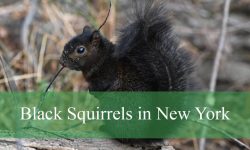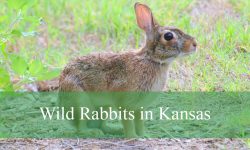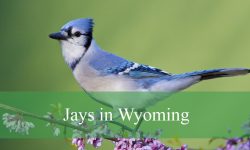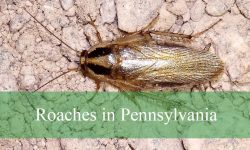North Dakota’s vast prairies, rolling hills, and rugged badlands create an ideal environment for one of the state’s most adaptable predators — the coyote. These intelligent canines roam nearly every landscape, from farmlands and open grasslands to river valleys and forested edges. Their haunting howls are a familiar sound beneath the wide Dakota sky.
Across the state, coyotes show remarkable variation in size, coat color, and behavior depending on their surroundings. Some have light tan fur that blends into the prairie grass, while others develop thick, silvery coats to endure the northern snow. Each type reveals a fascinating story of adaptation and survival in North Dakota’s changing seasons.
In this guide, you’ll explore five types of coyotes found in North Dakota, complete with pictures and identification details. You’ll learn how to recognize their unique traits, understand their behaviors, and discover where each type thrives in the state’s diverse ecosystems.
Common Types of Coyotes Found in North Dakota
Plains Coyote (Canis latrans latrans)
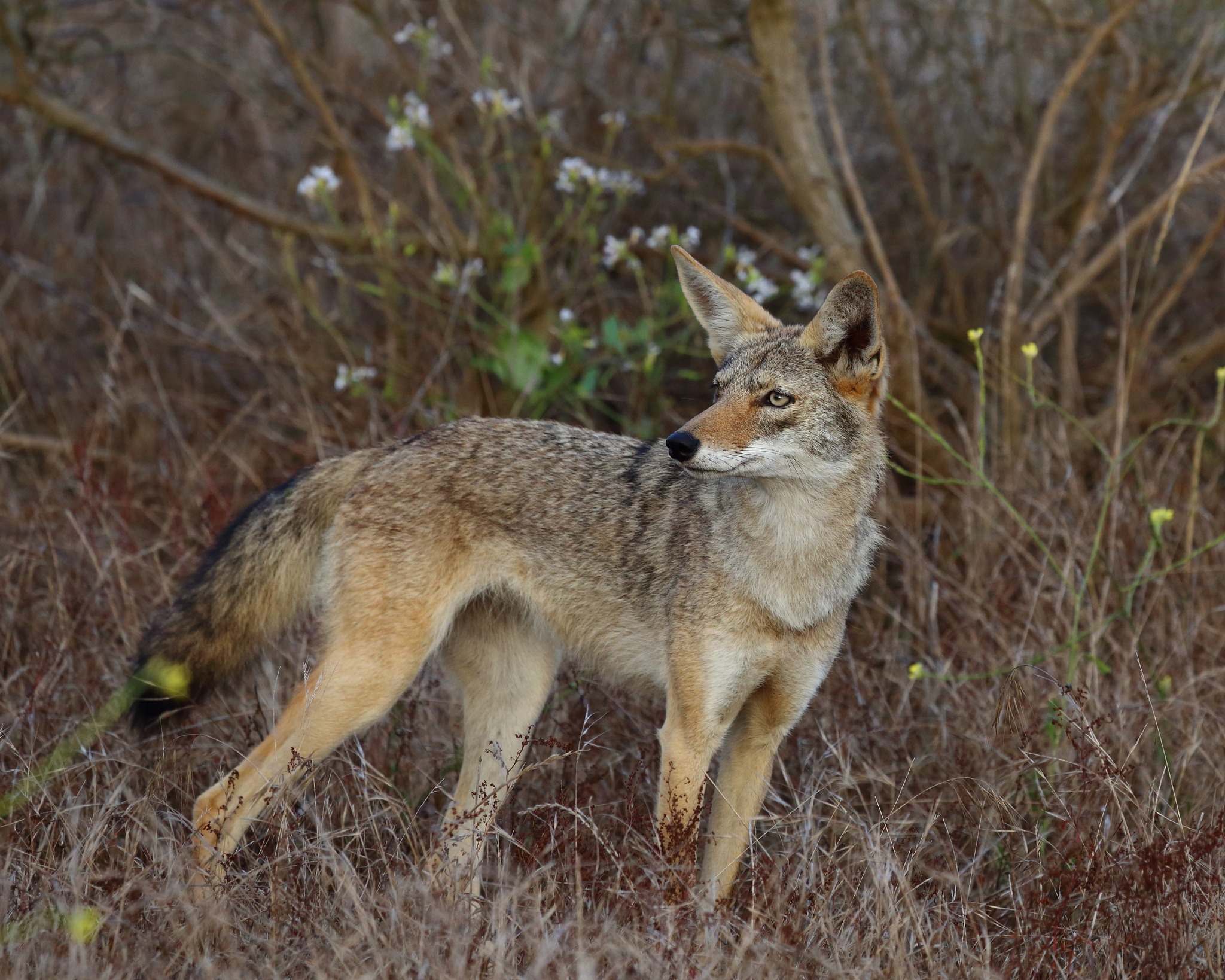
The Plains Coyote is the most common and widespread subspecies in North Dakota, thriving across the state’s open prairies, farmlands, and mixed-grass regions. This coyote is well adapted to the flat, windswept landscapes of the northern Great Plains, where visibility is vast and cover is sparse. Its coat blends seamlessly with the dry grasses and soil, giving it an advantage in camouflage against both predators and prey.
Adult Plains Coyotes typically measure between 40 to 50 inches in length, including the tail, and weigh between 20 and 35 pounds. Their coats vary seasonally — lighter tan and gray during the summer, and thicker, grizzled fur in winter months. Their pointed ears and narrow snout give them a keen, alert appearance, while their long, bushy tails often show a black tip that helps with balance and communication.
Behaviorally, the Plains Coyote is known for its intelligence and adaptability. These animals can live alone, in pairs, or as part of a small family group. They communicate through a range of yips, barks, and howls that echo across the prairie during twilight hours. Coyotes are both nocturnal and crepuscular, though they may be seen in daylight, particularly during the colder months when food is scarce.
When it comes to feeding, the Plains Coyote is an opportunistic hunter. It preys mainly on small mammals such as voles, rabbits, and ground squirrels but will also scavenge carrion and raid agricultural fields for fruits or grains. In farming regions, they occasionally prey on poultry or young livestock, which can bring them into conflict with humans.
Across North Dakota, this subspecies is most abundant in the central and eastern grasslands, though it can be found statewide. Its remarkable ability to adapt to human-altered environments has allowed it to persist even near rural communities, thriving along fencerows, drainage ditches, and field margins.
Mountain Coyote (Canis latrans lestes)
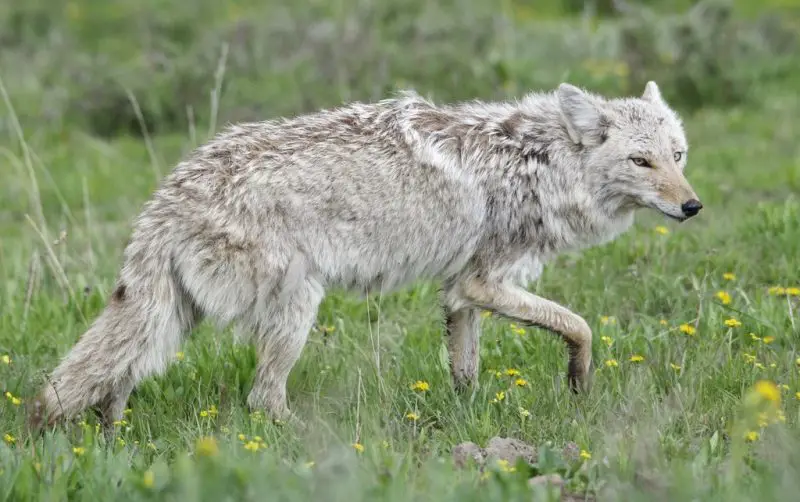
The Mountain Coyote is occasionally found in the western and southwestern parts of North Dakota, particularly near the rugged Badlands region and along the Missouri River breaks. This subspecies favors higher elevations and broken terrain, where cliffs, ravines, and sparse juniper woodlands provide excellent cover. Though less common than the Plains Coyote, it is equally resilient and intelligent.
Mountain Coyotes are typically larger and heavier, ranging from 30 to 45 pounds, with males generally outweighing females. Their fur is dense and often darker gray, peppered with black and buff hues that help them blend into rocky environments. Their legs appear slightly longer and more muscular, a trait useful for traversing uneven terrain and deep snow.
These coyotes display a more territorial nature compared to their plains counterparts. They often maintain and defend specific hunting areas, using prominent howls to communicate boundaries. They are adept climbers and can navigate steep slopes with ease, often using elevated areas as vantage points to scout for prey.
Their diet mirrors that of other coyotes but with more emphasis on larger prey and carrion. In the rugged habitats of western North Dakota, they frequently hunt deer fawns, ground-nesting birds, and smaller rodents. During winter, when food becomes limited, Mountain Coyotes scavenge carcasses left by wolves or human hunters.
In North Dakota, Mountain Coyotes are most frequently seen in the southwestern counties such as Billings, Slope, and Golden Valley, where the landscape is rougher and less cultivated. They tend to avoid open farmland, preferring the wild, broken terrain where they can remain elusive and undisturbed.
Northern Coyote (Canis latrans incolatus)
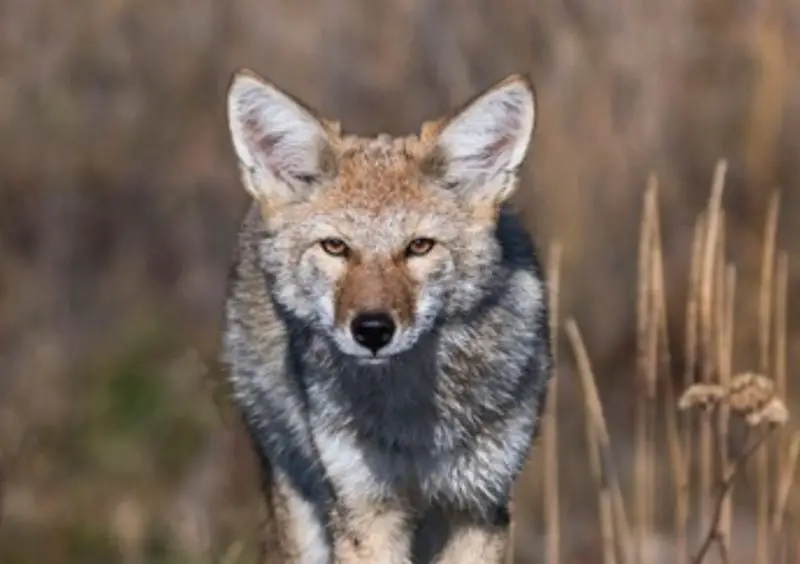
The Northern Coyote occupies the colder, northernmost reaches of North Dakota, particularly near the Canadian border. Adapted for harsh winters and snow-covered landscapes, this coyote variation exhibits some of the thickest and most luxurious fur of all coyote types in the state. Its light-gray to silver coat reflects its adaptation to cold climates and snowy environments.
This subspecies is medium to large in size, averaging 35 to 45 pounds, and has a compact, muscular body designed for endurance in deep snow. The fur around its neck and shoulders is especially dense, offering insulation during frigid northern winters. The face appears slightly broader, with small, rounded ears that reduce heat loss.
Northern Coyotes are solitary hunters for much of the year, though they may form small family groups during breeding and pup-rearing seasons. They are remarkably resourceful, capable of adjusting their hunting tactics based on seasonal prey availability. In summer, they hunt rodents and birds, while in winter they rely heavily on carrion and scavenging.
Their behavior tends to be less vocal and more cautious than coyotes living in open prairies. Due to the sparse human population in northern areas, these coyotes maintain a lower profile, often moving at dawn or dusk. They also develop thicker fat reserves in autumn to endure long, food-scarce winters.
Within North Dakota, Northern Coyotes are most commonly found in the Turtle Mountains and Pembina Hills region, extending westward toward Bottineau and Rolette Counties. Their ability to thrive in cold, forested, and semi-open habitats highlights their incredible adaptability across biomes.
Hybrid Coyotes (Coywolf and Coydog Mixes)
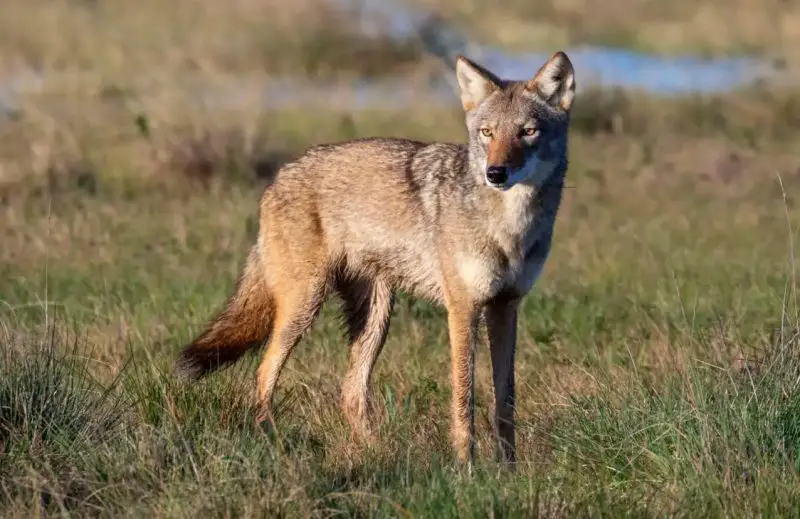
Hybrid Coyotes, often referred to as Coywolves (coyote–wolf hybrids) or Coydogs (coyote–domestic dog hybrids), are rare but occasionally encountered in North Dakota. These hybrids arise when coyotes interbreed with either gray wolves or domestic dogs, leading to individuals that exhibit a blend of physical and behavioral traits.
Coywolves tend to be larger and more robust, sometimes exceeding 50 pounds, with broader heads, shorter snouts, and a powerful jawline reminiscent of wolves. Their coat coloration can vary widely — gray, brown, or even black — and they often display a deeper chest and longer legs. Coydogs, on the other hand, may show unpredictable variations in fur color and ear shape, reflecting their mixed ancestry.
Behaviorally, hybrids often inherit enhanced strength and intelligence, but also less predictable social behavior. Coywolves may exhibit stronger pack tendencies and more aggression toward competitors, while Coydogs may show reduced fear of humans or unusual diurnal activity. Their vocalizations can also differ — a lower-pitched howl or shorter bark compared to pure coyotes.
These hybrids are opportunistic feeders, preying on small mammals, deer fawns, and carrion while scavenging human refuse when available. Their adaptability allows them to thrive near agricultural zones or forest edges, though they remain less common than pure coyotes due to natural reproductive and behavioral barriers.
In North Dakota, hybrid coyotes are most likely found along the eastern edge of the state, near forested areas close to Minnesota, where remnant wolf populations and rural dogs overlap with coyote ranges. Observations remain sporadic, but DNA evidence suggests limited hybridization events have occurred in the region.
Prairie Coyote (Color Morph of Canis latrans latrans)
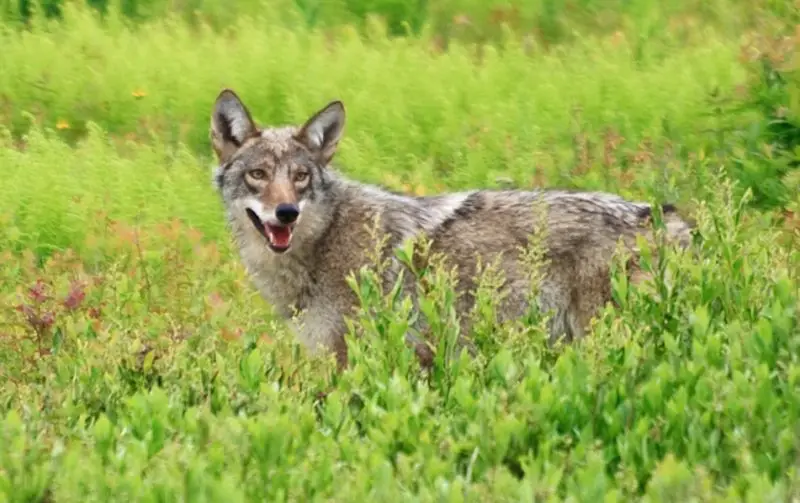
The Prairie Coyote is not a separate subspecies but rather a color morph of the Plains Coyote that dominates the central and eastern prairies of North Dakota. These coyotes are distinguished by their lighter, reddish-tan coats that blend perfectly with tallgrass and mixed-grass prairie ecosystems. Their subtle color variation provides ideal camouflage against golden fields and sunlit plains.
Prairie Coyotes are slightly smaller than the typical Plains type, averaging 20 to 30 pounds. Their fur appears smoother and less grizzled, especially in summer, while winter coats become fluffier with pale underbellies. Their facial features remain sharp and pointed, with amber eyes and keenly upright ears that catch even the faintest rustle of movement.
Behaviorally, these coyotes exhibit classic prairie-hunting tactics: stalking, pouncing, and cooperative flushing of small mammals from cover. They frequently hunt meadow voles, cottontail rabbits, and grasshoppers, supplementing their diet with fruits such as chokecherries and buffalo berries in late summer. Their ability to detect and adapt to prey movements across open landscapes is remarkable.
These coyotes are also highly social and vocal, especially during breeding season. They use long, echoing calls to communicate across open terrain, maintaining pair bonds and territory boundaries. Prairie Coyotes are often seen during early morning or twilight, when temperatures are cooler and prey is active.
Across North Dakota, the Prairie Coyote morph is most abundant in central and southeastern counties such as Barnes, Stutsman, and Cass. Their presence in cultivated farmlands and prairie remnants reflects their capacity to coexist with humans while still depending on native grassland ecosystems for survival.
Tips for Observing Coyotes in North Dakota
1. Look for Signs at Dawn and Dusk
Coyotes in North Dakota are most active during the early morning and late evening. These crepuscular hours offer the best chance to observe them hunting or traveling between denning and feeding areas. Listen for their howls and yips, which often start just before sunset and carry across open prairies. Their tracks are narrow and oval-shaped, with visible claw marks, similar to small dog prints but more compact.
2. Use Binoculars in Open Landscapes
Since much of North Dakota consists of open grasslands and farmland, binoculars are essential for spotting coyotes at a distance. Scan along fencerows, grassy ridges, or snow-covered fields, especially in winter when their movement stands out against white terrain. Coyotes are wary of humans, so keeping your distance increases your chance of prolonged observation.
3. Learn to Distinguish Howls and Calls
Coyotes have a wide vocal range — from high-pitched yips to deep, drawn-out howls. In North Dakota’s wide-open spaces, these calls can be heard for several miles. A series of short yips followed by a long howl often indicates a family group or territory communication. Recognizing these vocal patterns helps you understand local coyote behavior without needing to see them.
4. Watch for Seasonal Activity Changes
In late winter and early spring, coyotes pair up for breeding and become more vocal. By summer, they focus on raising pups and teaching them to hunt, so sightings near den sites or grassy embankments become more common. In fall, young coyotes disperse to establish their own territories, increasing the likelihood of encounters near rural or suburban edges.
5. Practice Ethical Wildlife Viewing
When observing coyotes, maintain a respectful distance and avoid feeding or attempting to attract them. Feeding wild coyotes can disrupt their natural behavior and create dependency. If photographing, use a telephoto lens and stay quiet — their hearing is sharp, and even small movements can startle them. Always remember that coyotes play a crucial role in controlling rodent populations and maintaining ecosystem balance.
FAQs About Coyotes in North Dakota
What do coyotes eat in North Dakota?
Coyotes are opportunistic feeders that adapt their diet to seasonal availability. In North Dakota, they mainly consume rabbits, mice, voles, and ground squirrels. During summer, they also eat insects, fruits, and berries. In winter, they scavenge deer carcasses and other carrion left by hunters or harsh weather, helping clean the environment.
Are coyotes dangerous to humans or pets?
Coyotes are naturally cautious and rarely pose a threat to humans. However, they may view small pets as potential prey, especially at night or near wooded edges. Keeping cats indoors and supervising dogs during evening hours reduces conflict. Most coyote encounters end with the animal fleeing once it detects human presence.
Where are coyotes most commonly found in North Dakota?
Coyotes are found statewide, but populations are densest in central and western regions where open prairies and badlands offer ideal hunting terrain. They also inhabit agricultural zones, drainage areas, and wooded river valleys. Their adaptability allows them to thrive even near rural communities and city outskirts like Bismarck and Minot.
Do coyotes form packs like wolves?
Coyotes typically live in small family groups, not large packs like wolves. A breeding pair and their pups may hunt together, but they often forage individually. During harsh winters or in areas with abundant prey, they may temporarily form small hunting groups to take down larger animals such as deer fawns.
What’s the best season to spot coyotes in North Dakota?
Winter is the best time to see coyotes. Their thick coats stand out against snow, and food scarcity makes them more active during daylight. Early spring is another good period, as breeding pairs become vocal and visible while searching for denning areas. Summer sightings are less frequent since coyotes remain near dens raising young.

